Alphabet & Number Series PYQ | Mathematical Reasoning and Aptitude for UGC NET PDF Download
Q1: Consider the following letter series AA,BD,CI, DP, ?, ... The next term (?) in the series is (December 2023)
(a) ES
(b) EV
(c) EY
(d) EB
Ans: (c)
Sol:
Given series is "AA, BD, CI, DP, ?,...
Series is divided in two parts.
First part is A, B, C, D, E....
Second part A+2 missing (B,C)=D;D+4 missing (E,F,G,H)=I;I+6 missing (J,K,L,M,N,O)=,P. Thus, next P+8 missing (Q,R,S,T,U,V,W,X)=Y
So, the missing term =EY
Q2: Consider the following number series: 1,3,7,15, 31,?…. (December 2023)
(a) 42
(b) 52
(c) 62
(d) 63
Ans:
Sol:
3 = (1 × 2) + 1
7 = (3 × 2) + 1
15 = (7 × 2) + 1
31 = (15 × 2) + 1
63 = (31 × 2) + 1
So, 63 is the missing number.
Q3: What number would replace question mark (?) in the series given below? (June 2023)
3,8,17,32,57,?,177
(a) 100
(b) 89
(c) 95
(d) 106
Ans: (c)
Sol: The differences between consecutive terms are:
The differences are increasing by
The next difference will be
Q4: What number should replace the question mark (?) in the following series: 450,473,519,588,680,795 ? (March 2023)
(a) 933
(b) 950
(c) 138
(d) 82
Ans: (a)
Sol:
450 + (23 × 1) = 473
473 + (23 × 2) = 473 + 46 = 519
519 + (23 × 3) = 588
588 + (23 × 4) = 680
680 + (23 × 5) = 795
795 + (23 × 6) = 933
So, 933 is the next number in the series.
Q5: Sum of 3 consecutive odd numbers and 3 consecutive even numbers together is 231 . Also the smallest odd number is 11 less than the smallest even number. What is the sum of the largest odd number and the largest even number? (March 2023)
(a) 81
(b) 73
(c) 77
(d) 79
Ans: (a)
Sol: Difference between smallest odd and smallest even number = 11
Let the smallest odd number = x
Then, the smallest even number = x + 11
Three odd numbers = x, x + 2, x + 4
Three even numbers = x + 11, x + 13, x + 15
Sum of all these 6 numbers = 231
6x + 45 = 231
6x = 231 – 45 = 186
So, x = 186 / 6 = 31
Q6: Choose the set of numbers, similar to the set (31,19,41) out of the following: (September 2022)
A. (27,29,47)
B. (23,34,49)
C. (29,16,41)
D. (29.17,37)
E. (23,37,49)
Choose the correct answer from the options given below:
(a) A, C and E only
(b) A and B only
(c) B and D only
(d) D only
Ans: (d)
Sol: The numbers are prime numbers in the set of numbers given in the question. All the sets in the options have at least one divisible number except option d.
Q7: Unscramble the strings below to create a meaningful word and then find the odd one out: (September 2022)
A. EIWNTR
B. UMRSME
C. PIGRSN
D. LCUOD
Choose the correct answer from the options given below:
(a) A only
(b) B only
(c) C only
(d) D only
Ans: (d)
Sol: All other options can be used in words with relation.
EIWNTR = WINTER
UMRSME = SUMMER
PIGRSN = SPRING
LCUOD = CLOUD
So, option D is odd.
Q8: How many terms are there in the series 168,175,182,_____ , 266 ? (November 2021)
(a) 13
(b) 14
(c) 15
(d) 16
Ans: (c)
Sol: The difference between every number is 7
Starting from 168 and ending at 266
Difference between the largest and smallest term = 266 – 168 = 98
98 / 7 = 14
Number of terms in series = 14 + 1 = 15
1 is added because while calculating the difference, the first term is neglected, and we have to consider every term of the series.
Q9: The next number in the given series is 196, 384, 736, ______ (November 2020)
(a) 1344
(b) 1244
(c) 1434
(d) 1544
Ans: (a)
Sol: The sequence is:
The first number is 196 and,
(196 × 2) – 8 = 384
(384 × 2) – 32 = 736, where 8 × 4 = 32
So,
(736 × 2) – 128 = 1344, where 32 × 4 = 128
Q10: Find the missing letters in the series: BCA, YZX, FED, ________ , HIG (November 2020)
(a) UVW
(b) VWU
(c) WVU
(d) VUW
Ans: (b)
Sol: The sequence of the alphabet is reversed from right to left with the letter in between two letters. For example in “BCA”, it is A and B in reverse with C in between.
Q11: The next term of the series is (December 2019)
1D3, 3H5, 5L7,_______
(a) 7P9
(b) 7R 9
(c) 7N9
(d) 7L9
Ans: (a)
Sol: Numbers are written in one gap like 1-3, 3-5, 5-7. So the number will be 7-9. Alphabets are written at the gap of 3 like- D- e f g- H- i j k- L. So next alphabet will be L-m n o -P.
Q12: Choose the missing term out of the given alternatives: QPO, NML, KJI, ______ (June 2019)
(a) HGF
(b) CAB
(c) JKL
(d) GHI
Ans: (a)
Sol: The alphabets in the series are written in reverse order like, QPO is in reverse order. Also, the entire series of alphabets is written backwards. So, the correct option is HGF.
Q13: The sum of all even natural numbers between 1 and 81 is (June 2019)
(a) 3280
(b) 3321
(c) 1646
(d) 1640
Ans: (d)
Sol: Total even numbers from 1 to 81 = 40
Sum of even numbers = N/2 * (F + L)
Where N = 40, F = 2, L = 80
Sum = 40/2 * (2 + 80)
Sum = 1640
Q14: In the sequence of numbers 2,8,26,62,122,212,x,….. , the term x is: (December 2018)
(a) 338
(b) 248
(c) 332
(d) 302
Ans: (a)
Sol: Total even numbers from 1 to 81 = 40
Sum of even numbers = N/2 * (F + L)
Where N = 40, F = 2, L = 80
Sum = 40/2 * (2 + 80)
Sum = 1640
We will make 3 series to solve this question.
In the 1st series: 2, 8, 26, 62, 122, 212 the difference in digits is:
2nd series: 6, 18, 36, 60, 90; and in series no. 2 the difference in digits is:
3rd Series: 12, 18, 24, 30; and in series 3 the difference in digit is of 6 between each digit.
Now we will add numbers backwards. Hence, we need to add 6 in the last number of series no. 3 for the next term which will be (30 + 6) i.e., 36.
Add 36 to the last number of series no. 2 for the next number in that series. It will be 90 + 36 i.e., 126.
Now add 126 to the last number of the 1st series to get the next number of that series. It will be 212 + 126 i.e., 338.
Q15: The next term in the series -1,5,15,29,?,… is: (July 2018)
(a) 36
(b) 47
(c) 59
(d) 63
Ans: (b)
Sol: The difference between the terms of the series –1, 5, 15, 29 is: The difference between terms of series 6, 10, 14 is 4. Hence, adding 4 to 14, it will be 18.Adding 18 to 29, it will be 47.
The difference between terms of series 6, 10, 14 is 4. Hence, adding 4 to 14, it will be 18.Adding 18 to 29, it will be 47.
Q16: The next term in the series ABD, DGK, HMS, MTB, SBL, ? , ... is: (July 2018)
(a) ZKU
(b) ZCA
(c) ZKW
(d) KZU
Ans: (c)
Sol: The difference between letters is increasing with each word. Considering alphabets are written in a series:
A 0 B 1 D
D 2 G 3 K
H 4 M 5 S
M 6 T 7 B
S 8 B 9 L
Z 10 K 11 W
Q17: In the series 1,6,15,28,45, ______ the next term will be: (November 2017)
(a) 66
(b) 76
(c) 56
(d) 84
Ans: (a)
Sol: The difference between the two consecutive numbers of given are 5, 9, 13, 17.
The difference between the numbers of the second series is 4 (5-9-13-17).
Hence, adding 4 to 17 is 21.
Adding 21 to 45 is 66.
Q18: The next term in the series ABD, DGK, HMS, MTB, ......... is: (November 2017)
(a) NSA
(b) SBL
(c) PSK
(d) RUH
Ans: (b)
Sol: Calculating the difference between the alphabets of the series:
A0B1D
D2G3K
H4M5S
M6T7B
So, the next term can be S8B9L
Q19: The missing term in the series 1,4,27,16,?,36,343,… is (January 2017)
(a) 30
(b) 49
(c) 125
(d) 81
Ans: (c)
Sol: The numbers in the series are square and cubes of consecutive numbers alternatively.
(1)3 = 1
(2)2 = 4
(3)3 = 27
(4)2 = 16
(6)2 = 36
(7)3 = 343
Hence, the missing number will be cube of 5 i.e., (5)3 = 125
Q20: The next term in the following series YEB, WFD, UHG, SKI will be (January 2017)
(a) TLO
(b) QOL
(c) QLO
(d) GQP
Ans: (b)
Sol: The first terms in all series are alternate alphabets in backwards.
Y-W-U-S
The second term in all the series is in the forward sequence but the gap is increasing by one number.
E-F-1-H-2-K
The third term in all the series is in the forward sequence but the gap is by 1 or by 2 in an alternate manner.
B-1-D-2-G-1-I
Hence, the next term will be QOL
Q21: In certain code, SELECTION is coded as QCJCARGML. The code of AMERICANS will be (June 2016)
(a) YKCPGAYLQ
(b) BNFSJDBMR
(c) QLYAGPCKY
(d) YQKLCYPAG
Ans: (a)
Sol: The alphabets are coded in reverse with the gap of one alphabet.
Y 1 A
K 1 M
C 1 E
P 1 R
G 1 I
A 1 C
Y 1 A
L 1 N
Q 1 S
Q22: In the series 3,11,23,39,59,________ (June 2016)
The next term will be
(a) 63
(b) 73
(c) 83
(d) 93
Ans: (c)
Sol: By deducting the first number from the succeeding number, we get
11 – 3 = 8
23 – 11 = 12
39 – 23 = 16
59 – 39 = 20
Now the difference of 4 can be identified between the results i.e., 8,12,16,20. Hence the next number in result series will be 24.
Now adding 24 to 59, we get 83.
Q23: In the series
AB,EDC,FGHI,…. ?...., OPQRST, the missing term is (June 2016)
(a) JKLMN
(b) JMKNL
(c) NMLKJ
(d) NMKLJ
Ans: (c)
Sol: The alphabet in the series is in forward sequence and in reverse sequence alternatively. Also, the number of alphabets in each word is increasing by 1.
The series will be
AB
EDC
FGHI
NMLKJ
OPQRST
Q24: The next term in the series
2,5,10,17,26,37 ? is: (December 2015)
(a) 50
(b) 57
(c) 62
(d) 72
Ans: (a)
Sol: The difference between two terms in the given series is a sequence of prime numbers. 3,5,7,9,11 is the difference in the given series. Hence, next number will be 50 by adding 13.
Q25: The next term in the series: (December 2015)
B2E, D5H, F12K, H27N ? is:
(a) J56I
(b) I62Q
(c) Q62J
(d) J58Q
Ans: (d)
Sol: In the given series,
1. First alphabets of all terms are increasing by adding 2 alphabets in each term i.e., B + 2 = D, D + 2 = F, F + 2 = H, H + 2 = J.
2. Numbers in the middle are increasing by multiplication of 2 and then adding one to it i.e., (*2+1). Then (*2 + 2) (*2 + 3) and so on.
3. Third alphabets of all terms are increasing by adding 3 alphabets in each term i.e., E + 3 = H, H + 3 = K, K + 3 = N, N + 3 = Q
Hence, the next term is J58Q.
Q26: The next term in the series is: (June 2015)
2,5,9,19,37 ?
(a) 73
(b) 75
(c) 78
(d) 80
Ans: (b)
Sol: 2 × 2 + 1 = 5
5 × 2 – 1 = 9
9 × 2 + 1 = 19
19 × 2 – 1 = 37
37 × 2 + 1= 75
Q27: In certain code MATHURA is coded as JXQEROX. The code of HOTELS will be: (June 2015)
(a) LEQIBP
(b) ELQBIP
(c) LEBIQP
(d) ELIPQB
Ans: (d)
Sol: Step-1 Number the alphabet. For example a–1, b–2 in every alphabetical reasoning question to understand the pattern.
In this coding every alphabet is replaced with the alphabet having 3 back numbers.
M (number-13) is replaced by j (number-10) and a (number-1) is replaced by x(number-24)
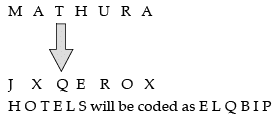
Q28: The next term in the series : (December 2014)
2,7,28,63,126, _________ is
(a) 215
(b) 245
(c) 276
(d) 296
Ans: (a)
Sol: The given series is a hybrid cubic series in which 1 is added and subtracted alternatively from the cube numbers.
13 + 1 = 2
23 – 1 = 7
33 + 1 = 28
43 – 1 = 63
53 + 1 = 126
So, the next term in the series would be 63 – 1 = 216 – 1 = 215.
Q29: The next term in the series : AB,ED,IH,NM, _______ is (December 2014)
(a) TS
(b) ST
(c) TU
(d) SU
Ans: (a)
Sol: In the given alphabetical series, the second alphabet of the next term is related with the second alphabet of the previous term. There is an increasing shift (+2, +3……….) in the next term with the previous term e.g., B + 2 = D and so on. The logical pattern is shown below, so following the same pattern, the answer will be option (a) TS.
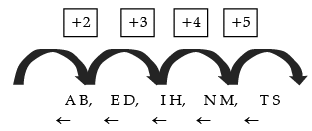
Q30: In certain coding method, the word QUESTION is encoded as DOMESTIC. In this coding, what is the code word for the word RESPONSE ? (June 2014)
(a) OMESUCEM
(b) OMESICSM
(c) OMESICEM
(d) OMESISCM
Ans: (c)
Sol: Code can be identified with the given code of QUESTION.
Q-D
U-O
E-M
S-E
T-S
I-T
O-I
N-C
Similar with that, R:
E:-M
S:-E
P:-
O:-I
N:-C
S:-E
E:-M
Only the code for R and P is not given. This can be assumed from options.
Q31: If the series 4,5,8,13,14,17,22,…. is continued in the same pattern, which one of the following is not a term of this series? (June 2014)
(a) 31
(b) 32
(c) 33
(d) 35
Ans: (c)
Sol: The series is formed with the gap of 1, 3, and 5 repeatedly.
The series will be continued as follows:
4, 5, 8, 13, 14, 17, 22, 23, 26, 31, 32, 35, 40
The number 33 will not be in the given series.
Q32: Complete the series BB, FE, II, ML, PP, ..........by choosing one of the following option given : (June 2014)
(a) TS
(b) ST
(c) RS
(d) SR
Ans: (a)
Sol:

Q33: In this series
6,4,1,2,2,8,7,4,2,1,5,3,8,6,2,2,7,1,4,1,3,5, 8,6 , how many pairs of successive numbers have a difference of 2 each ? (December 2013)
(a) 4
(b) 5
(c) 6
(d) 8
Ans: (c)
Sol: 6, 4, 1, 2, 2, 8, 7, 4, 2, 1, 5, 3, 8, 6, 2, 2, 7, 1, 4, 1, 3, 5, 8, 6
Pairs in red color have a difference of 2.
Q34: The missing term in the series (September 2013)
2,7,24,77,?,723 is
(a) 238
(b) 432
(c) 542
(d) 320
Ans: (a)
Sol: The series is formed by multiplying by 3 and adding odd numbers.
2 × 3 + 1 = 7
7 × 3 + 3 = 24
24 × 3 + 5 = 77
77 × 3 + 7 = 238
Q35: The missing number in the series 40,120,60,180,90,?,135 is (June 2013)
(a) 110
(b) 270
(c) 105
(d) 210
Ans: (b)
Sol:The series is following the pattern of × 3 ÷ 2
40 × 3 = 120
120 ÷ 2 = 60
60 × 3 = 180
180 ÷ 2 = 90
90 × 3 = 270
270 ÷ 2 = 135
Q36: The missing number in the series : 0,6,24,60,120,?,336, is (December 2012)
(a) 240
(b) 220
(c) 280
(d) 210
Ans: (d)
Sol:

Q37: Which is the number that comes next in the following sequence? (June 2012)
2,6,12,20,30,42,56, _________
(a) 60
(b) 64
(c) 72
(d) 70
Ans: (c)
Sol: The series is given by adding even numbers:
2 + 4 = 6
6 + 6 = 12
12 + 8 = 20
20 + 10 = 30
30 + 12 = 42
42 + 14 = 56
56 + 16 = 72
Q38: Find the next letter for the series YVSP _________
(a) N
(b) M
(c) O
(d) L
Ans: (b)
Sol: Option (b) is correct.
Y – 2 = V
V – 2 = S
S – 2 = P
P – 2 = M
Q39: What is the number that comes next in the sequence? 2,5,9,19,37, (December 2011)
(a) 76
(b) 74
(c) 75
(d) 50
Ans: (c)
Sol: The series is formed as a double with adding and subtracting 1.
2 × 2 + 1 = 5
5 × 2 – 1 = 9
9 × 2 + 1 = 19
19 × 2 – 1 = 37
Next term will be 37 × 2 + 1 = 75
Q40: Find the next letter for the series MPSV..... (December 2011)
(a) X
(b) Y
(c) Z
(d) A
Ans: (b)
Sol: The series is formed by skipping 2 letters of the alphabet.
M + 2 = P
P + 2 = S
S + 2 = V
V + 2 = Y
Q41: Find the wrong number in the sequence (June 2011)
125,127,130,135,142,153,165
(a) 130
(b) 142
(c) 153
(d) 165
Ans: (d)
Sol:

Q42: The letters in the first set have certain relationship. On the basis of this relationship, make the right choice for the second set : (June 2011)
K/T:11/20 :: J/R : ?
(a) 10/8
(b) 10/18
(c) 11/19
(d) 10/19
Ans: (b)
Sol: Letters are given their number of positions in the alphabet.
A = 1
B = 2
Like this,
K = 11
T = 20
J = 10
R = 18
Q43: Find the wrong number in the sequence : (December 2010)
52,51,48,43,34,27,16
(a) 27
(b) 34
(c) 43
(d) 48
Ans: (b)
Sol:
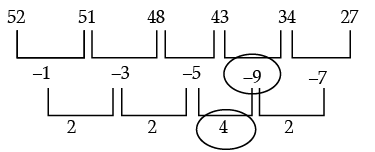
Q44: Find the next number in the following series : (June 2010)
2,5,10,17,26,37,50,?
(a) 63
(b) 65
(c) 67
(d) 69
Ans: (b)
Sol: 1 × 1 + 1 = 2
2 × 2 + 1 = 5
3 × 3 + 1 = 10
4 × 4 + 1 = 17
5 × 5 + 1 = 26
6 × 6 + 1 = 37
7 × 7 + 1 = 50
8 × 8 + 1 = 65
Q45: The next number in the series 2,5,9,19,37, ? will be (December 2009)
(a) 74
(b) 75
(c) 76
(d) None of the above
Ans: (b)
Sol: 2
2 × 2 + 1 = 5
5 × 2 – 1 = 9
9 × 2 + 1 = 19
19 × 2 – 1 = 37
37 × 2 + 1= 75
Double and addition and subtraction to each of one respectively.
Q46: What will be the next term in the following? (December 2009)
DCXW, FEVU, HGTS, ?
(a) AKPO
(b) ABYZ
(c) JIRQ
(d) LMRS
Ans: (c)
Sol: It is coded as + 2, + 2, – 2, – 2
D + 2 = F, F + 2 = H, Next first alphabet = H + 2 = J
C + 2 = E, E + 2 = G, Next = G + 2 = I
X – 2 = V, V – 2 = T, Next = T – 2 = R
W – 2 = U, U – 2 = S, Next = S – 2 = Q
Next term = JIRQ
Q47: Insert the missing number in the following : 3,8,18,23,33,?,48 (June 2009)
(a) 37
(b) 40
(c) 38
(d) 45
Ans: (c)
Sol: This Series is coded as +5, +10, +5, +10
3 (+5), 8 (+10), 18 (+5), 23 (+10), 33 (+5), 38 (+10), 48
Q48: The letters in the first set have a certain relationship. On the basis of this relationship mark the right choice for the second set:
BDFH : OMKI : : GHIK : ? (June 2009)
(a) FHJL
(b) RPNL
(c) LNPR
(d) LJHF
Ans: (b)
Sol:
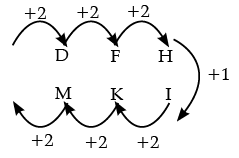
Similarly,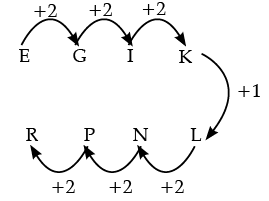
Q49: Find out the wrong number in the sequence. 52, 51, 48,43,34,27,16 (June 2009)
(a) 27
(b) 34
(c) 43
(d) 48
Ans: (b)
Sol:
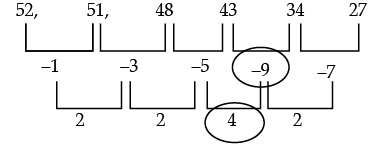
|
46 videos|91 docs|42 tests
|
FAQs on Alphabet & Number Series PYQ - Mathematical Reasoning and Aptitude for UGC NET
| 1. What are the key topics covered in the Alphabet & Number Series for UGC NET exam preparation? |  |
| 2. How can I effectively practice Alphabet & Number Series questions for the UGC NET exam? |  |
| 3. What strategies can I use to solve Alphabet & Number Series questions quickly? |  |
| 4. Are there any specific types of questions that frequently appear in the UGC NET Alphabet & Number Series section? |  |
| 5. How important is the Alphabet & Number Series section in the UGC NET exam? |  |
















